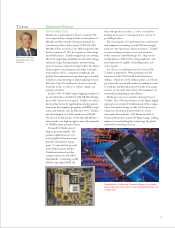Toshiba 1997 Annual Report Download - page 21
Download and view the complete annual report
Please find page 21 of the 1997 Toshiba annual report below. You can navigate through the pages in the report by either clicking on the pages listed below, or by using the keyword search tool below to find specific information within the annual report.
19.
What industry and technical themes are most important in
determining how Toshiba allocates its considerable R&D resources?
Toshiba is firmly committed to remaining at the forefront of the multimedia
field. We want to be a leader in the convergence of data, communications and
imaging technology. We place top priority on creating technologies that will
enable us to set the directions of new businesses. This is particularly true of
digital networks and mobile communications. The Internet, portable phones and
other new methods of communications are already an integral part of our lives.
As more such methods begin to take shape, our R&D programs must aim for
nothing less than setting international standards for emerging technologies.
The Advanced-I Project forms the blueprint for this drive into new fields.
Launched in July 1994, the Advanced-I Group cuts across Toshiba’s entire
organization. We have already seen several major achievements. The November
1996 introduction of the DVD-video player is the most obvious. Toshiba is now
firmly positioned among the leaders in this technology. We also make PCs with
DVD drives, DVD-ROM devices, DVD authoring systems and many other
related products. All draw on our expertise in optelectronics, semiconductor
lasers, image compression and many other fields.
A
Q
Semiconductor lithography is one example. Advances here have an immediate impact on the circuit
density of semiconductor devices. Toshiba leads the industry here. We have already reached the point where
we can use X-ray lithography to make prototypes of transistors for 4-gigabit-class DRAMs. Another example
is Toshiba’s line of portable information devices, including the Libretto mininotebook computer and our
pocket communicator. These products draw heavily on advances in high-density application-specific ICs and
ultra-slim 2.5-inch hard-disk drives.
Superconductivity holds much promise. We have developed a superconductive magnet that generates a
remarkably strong, uniform and stable magnetic field. Along with a high-performance freezing unit, this
technology is well suited to medical equipment. Our engineers have already used this breakthrough to
commercialize an MRI system that is much less restrictive for patients.
Numerous research projects were instrumental in our ability to create the world’s first advanced boiling-
water reactor, or ABWR. Toshiba designed a pump for recycling cooling materials that can be placed inside
the reactor. We came up with an improved drive mechanism for control rods. And we discovered a way to
make reactor enclosures out of reinforced concrete.
Research & Development Strategic Overview
A
19.
Information and communications equipment, PCs and electronic components are other strategic fields within our R&D program.
LCDs, rechargeable batteries and environmental systems are also areas where we are concentrating our R&D resources.
How does Toshiba ensure that R&D activities tie in with the need to create products for emerging opportunities
quickly, yet at the lowest possible cost?
Joint research programs are an important element of our R&D strategy. Sharing resources is often the best way to bring competitive
products to market in a short time. As a diversified manufacturer of electronic and electrical products, Toshiba covers a broad range of
fields, including materials, devices and systems. Our objective is to quickly transform these core technologies into viable products. To do
so, we form alliances at the initial research stage with prominent companies around the world. In 1992, we began working with IBM and
Siemens to develop 64M and 256M DRAMs. This project was completed six months ahead of schedule. Now the three partners plan to
take on the challenges of the next generation of memory devices.
Certain breakthroughs lead directly to next-generation products. The blue laser was instrumental to commercializing
DVD, for instance. Are there any recent achievements in this regard?
Q
A
The Tomorrow 21 Exhibition presented displays and lectures
covering about 100 examples of leading-edge technologies
created in Toshiba’s research labs. Held in March 1997, the
Tokyo event attracted a large audience.
Q
























